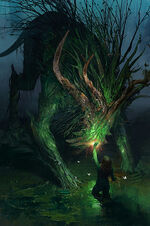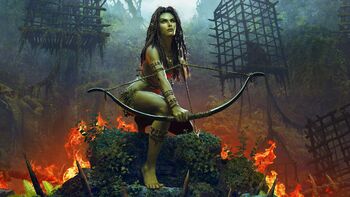| Brokilon Forest, he said, is forbidden territory. The kingdom of forest dryads. Brokilon also defends our flank. The dryads will not let anyone pass. The Nilfgaardians either... | |||
| - pg. 270, Blood of Elves (UK edition) | |||
Brokilon (Brokiloén in Elder Speech)[N 1][2] also known among humans as the Forest of Death,[3] is an ancient forest queendom on the Continent and the sole nonhuman state in Northern Realms never conquered nor subjugated by Nordlings. Ruled by dryads and hamadryads, it hosts many other races and species persecuted in the outside world.[2]
History
Early ages
According to the dwarven accounts, the dryads had been present in the world "since always",[4] some even speculated that they were here as early as the first tree, thus it can be assumed that Brokilon itself is equally old. When Aen Seidhe arrived in the Continent, dryads adopted certain elven customs as language, as well as interbred with them.[5] At least one elven town, Craag An, was built within the forest's borders but was abandoned and ruined unknown time later[2] as the forest's inhabitants were not very tolerant towards modifying natural environment in one's will.
Wars with humans
The biggest threat to the forest, however, was yet to come. Early after First Landing, humans perceived nymphs as monsters, demons who had to be either expelled or destroyed in order to obtain new lands. Leimoniads and oreads faced near extinction, the number of hamadriads decreasing with each cut tree.[5] While other dryad forests surrendered and eventually forged a relative peace with humans, who were after all potential fathers of their children, Brokilon never subjugated. The major, ongoing conflict started in the 11th century, over the course of which Brokilon lost, among others, Burnt Stump, Eight-Mile and Owl Hills. Dryads never recognized the human borders and continued to attack humans as far as Sodden.
13th century
Brokilon and its neighbouring Nordling realms remained hostile towards each other, though attempts at making peace were made by at least few human monarchs, such as Venzlav of Brugge. The negotiations were usually turned down by Queen Eithné who perceived most of the human side's conditions, such as giving up half of the forest, as unacceptable.[2]
During the Northern Wars Brokilon supported Scoia'tael guerrilla, providing them a safe place to retreat, heal and find guides. At the early stages of war, dryads organized ambushes at unsuspecting scalp hunters from Verden and Kerack who were lured into the forest by Milva, impersonating a "guide".
14th century
By the second half of the 14th century Brokilon still existed, perceived by humans as one of the few remaining primeval forests in the North.[1]
Geography
In the second half of the 13th century, Brokilon bordered Verden, Kerack, Brugge,[2] and Temeria.[6][5] Major landmarks on its borders are Tukaj Hills to the north,[7] Dol Adalatte to the northwest[2] and the Ribbon River to the east.[1]
Not more than a century earlier the forest stretched further east, encompassing also Burnt Stump, Eight-Mile and Owl Hills. It is worth to note that Brokilonian dryads did not recognized 13th century's borders and attacked humans as far as Sodden.[2]
Fauna and Flora

Hamadryad animating a treant fiend
Due to its climate and the care of hamadryads, Brokilon is habitat to many plants and mushrooms not encountered in any other Northern Realm, such as knitbone and conynhaela.[3] Many species of trees grow here, including cedar, oak, hickory, mahogany, golden birch, yew, and pine.[2] Flowers of Brokilon are said to bloom even up to seven times a year.[8]
The forest hosts many animals, including deer and wild boars.[1] It is however also a home to more hostile monsters, such as giant centipedes,[2] treants,[8] and vyppers.[5]
Society
Demographics
Brokilon is inhabited by numerous intelligent races, some of them almost extinct outside of the forest's border. Apart from the dryads and hamadryads, one can encounter leprechauns, pucks[2] and other nymphs such as rusalkas. The dryad society does not include members of these other races, but dryads occasionaly meet them in order to mate.[5]
Structure of the society
Dryads of Brokilon are organized in a quasi-monarchic society, for centuries led by Queen Eithné residing in Duén Canell.[2] She administered the forest through messengers and operatives, such as Sinéad[5] and Milva.[1] Non-dryad Brokilonian races tend to live solitary or form small communities.[5]
Culture
As forest nymphs, dryads are spiritually connected to the nature. They seem not to have objections against hunting but deeply care for trees and other plants. It is absolutely forbidden to bring fire into the forest or to cut a tree with axe.[1] Instead of cutting wood to construct buildings, hamadryad magic allows the dryads to shape the living trees and shrubs whichever way they want. This way, they can have huts, or even large houses, either on the ground or in the treetops.
Military

Dryads are known for their amazing archery skills and can easily kill a human from the distance of 200 feet without the person ever knowing they were there. They use this ability extensively to mark their border: if an arrow lands at one's feet or in a nearby tree, that's as far as the intruder is allowed to travel alive as the next shot, should they not heed the warning, will kill them. To prevent the decay of bodies from filling the air, the dryads tend to mark their border by the rivers so the bodies can be washed away with the current.
Apart from bows, dryads utilize also several kinds of traps to protect their forest. As they are nearly invisible for even the most suspecting eye, a safe travel through the forest is practically impossible without a native guide.[2] They may also create a disorienting magical fog or lure people into monster lairs.[5] In close combat, dryads seem to use wooden spears or javelins,[9] and knives.[8]
Around the early stages of Northern War II, Eithné and Milva introduced a new, more proactive strategy of thinning the ranks of Brokilon's opponents from Verden and Kerack. Impersonating a guide, Milva used to lure unsuspecting scalp hunters into the ambushes by dryad archers. Four such "expeditions" were organized, and the last one caused deaths of approximately 100 humans.[1]
Notable People
For a full list of Brokilonians, see [[::Category:Brokilonians]].
Locations
- the Vda
- Seventh Mile
- Eight-Mile (disputed with Brugge)
- Burnt Stump (disputed with Brugge)
- Owl Hills (disputed with Brugge)
Footnotes
- ↑ "Feainn" or "caelm" are standard nouns, but with suffix "-e" they are nouns in genitive case or adjectives - like in "Feainnewedd" (Child of Sun, Sun-Child) or "caelme tedd" (quiet time, time of quiet?). "Wedd Brokiloéne" means clearly "Child of Brokilon", and it contains the exact suffix "-e".
References
- ↑ 1.0 1.1 1.2 1.3 1.4 1.5 1.6 Baptism of Fire
- ↑ 2.00 2.01 2.02 2.03 2.04 2.05 2.06 2.07 2.08 2.09 2.10 2.11 2.12 Sword of Destiny
- ↑ 3.0 3.1 Time of Contempt
- ↑ Blood of Elves
- ↑ 5.0 5.1 5.2 5.3 5.4 5.5 5.6 5.7 Wiedźmin: Gra Wyobraźni
- ↑ World map#Stanislav Komárek
- ↑ Season of Storms
- ↑ 8.0 8.1 8.2 Template:Gwent standalone
- ↑ Template:Witcher TV
